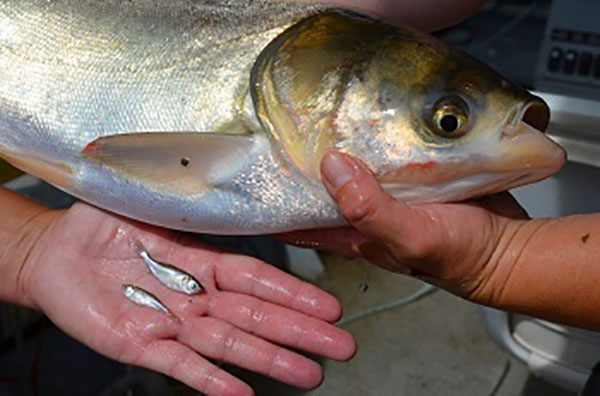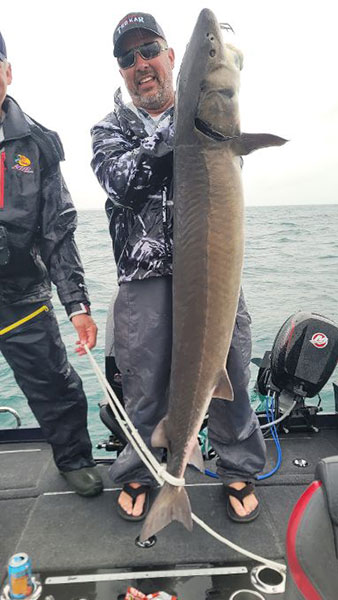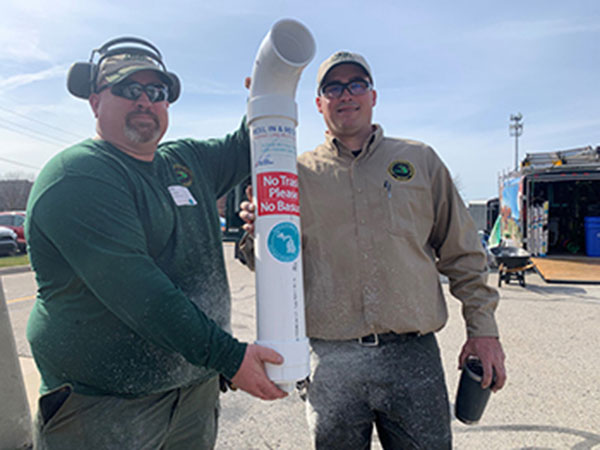- Details
MDNR Report
More than 269 tons of fish, eight different species, plus one hybrid, and a total of 9,335,410 individual fish – it all adds up to successful spring and summer stocking efforts by the Michigan Department of Natural Resources, and some great fall fishing for anglers.
Stocking is no small task. Over the course of 2,233 hours and more than 89,000 miles, DNR fisheries crews in 17 specialized trucks took 375 trips to stock fish at 705 different sites.
"We had excellent spring and summer stocking seasons that will bring significant benefits and fishing opportunities to Michigan anglers," said Ed Eisch, DNR fish production manager. "With the hard work and dedication of our staff, healthy, high-quality fish were reared and delivered to stocking sites in excellent condition. The numbers produced and stocked were right on target for most areas."
The number and type of fish produced varies by hatchery, as each location’s ability to rear fish depends on the source and temperature of the rearing water. In Michigan there are six state and two cooperative hatcheries that work together to produce the species, strain and size of fish needed for fisheries managers. These fish must then be delivered and stocked at a specific time and location to ensure their success.
- Details
MDNR Report
Just in time for fall hunting and fishing – hunters, anglers and boaters have a new option to earn the required recreational safety certificate before hitting the woods or water.
The Michigan Department of Natural Resources now offers hunter education and boater safety as interactive online courses, giving students an enhanced experience that exposes them to real-life hunting and boating scenarios.
“We’re excited to offer students this new learning opportunity,” said Lt. Tom Wanless, DNR recreational safety, education and enforcement supervisor. “Both the interactive hunting and boating programs are offered in other states and have received ‘five star’ reviews.”
The interactive learning options are offered in addition to the existing traditional classroom and online learning options for both hunter and boater safety; hunter safety continues to be available as a take-home study course, too.
While virtually navigating a vessel, students may approach a sailboat and must determine the best way to manage the encounter. Or, while learning the different parts of a firearm, they will be asked to click the circle that points to the safety.
“The difference between the online interactive and online courses is that the interactive courses include virtual elements that engage students to make their own critical decisions throughout the lesson,” Wanless said. “It’s a more hands-on learning approach compared to the traditional online courses.”
Interactive hunter safety
Featuring 45 interactive assessments, the ilearntohunt content is reviewed and approved by the International Hunter Education Association U.S.A. Students actively participate from the comfort of their own learning setting. Once they successfully navigate their personalized hunting experience, students will need to attend the required in-person field day to receive their hunter safety certificate.
Field days are in-person, one-day sessions in which students must demonstrate a variety of skills, such as safe firearm handling and shooting.
- Details
MDNR Report
 Invasiv Bighead Carp
Invasiv Bighead Carp
Routine environmental DNA (eDNA) surveillance for invasive bighead and silver carp, conducted annually by the U.S. Fish and Wildlife Service, turned up a single positive sample in the St. Joseph River near the St. Joseph/Benton Harbor area, according to data provided to the Michigan Department of Natural Resources on Aug. 28.
Of 220 water samples collected in June 2023 from stretches of the river between Lake Michigan and Berrien Springs, only one, taken near Marina Island, showed evidence of genetic material from silver carp.
“A positive eDNA sample does not necessarily indicate the presence of live fish,” said Seth Herbst, DNR Fisheries Research Program manager. “It is possible for genetic material to be introduced from other sources, such as boats or fishing equipment used in another state where invasive carp are present, then transported and used in Michigan waters.”
The Marina Island area is home to multiple marinas and a city boat launch with high recreational use by locals and visitors accessing the St. Joseph River and Lake Michigan. The positive detection occurred directly in front of a marina, suggesting boater traffic may have contributed to the detection.
- Details
By Louie Stout
 Scott Solomon with big sturgeon
Scott Solomon with big sturgeon
Scott Solomon not only won the junk fish pot in a tournament on St. Clair, but he blew it away.
Solomon was fishing a 2.75-inch tube on a 3/8-ounce jighead when a giant sturgeon clamped on during the Dearborn Firefighters fundraiser tournament.
And he landed the 60-inch, 75-pound monster that fish biologists estimate to be more than 25 years old.
It took him 30 minutes and he had the fish to the boat five times before he, Chad and George Lovell finally wrestled it into the boat.
And yes, it was hooked in the mouth. He caught the fish on 40-pound PowerPro braid and an American Angler spinning rod and Team Lew’s spinning reel.
“That reel took a pounding,” said Solomon, who lives in Edwardsburg, Mich. “We released the fish and provided the photo as proof to the tournament officials.”
The team finished fifth overall in the tournament.
- Details
MDNR Report
 Fishing line recycling tube
Fishing line recycling tube
Thanks to the kindness of thousands of campers and boaters who gave an additional $2 when making their camping or boating reservation, the DNR is rolling out fishing line recycling tubes this summer and fall (with many in southern Michigan already in place).
With the help of Michigan Cares for Tourism volunteers who are building the tubes, the DNR is working to place them at every harbor, boating access site and fishing pier throughout the state's parks and recreation system. These recycling tubes will help protect aquatic wildlife from the dangers of eating or getting tangled in fishing line and other fishing tackle. It also helps protect boat propellers. Find other new sustainable boating efforts and BoatUS Foundation's video on why to recycle fish line.


